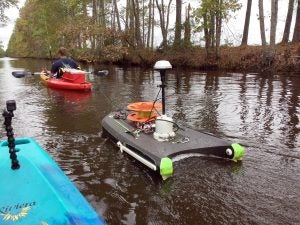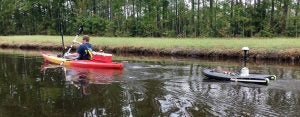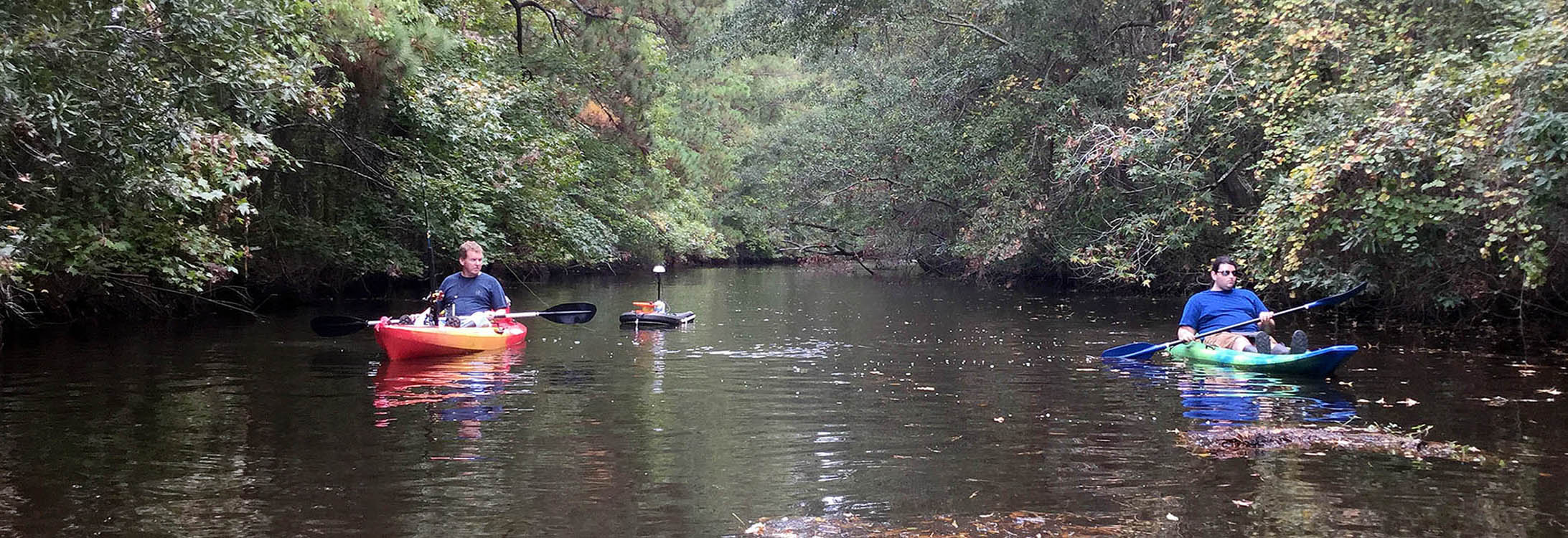RISING TIDE OF RESEARCH
ECU team gets grant to help communities adjust to sea level rise

Dr. Randall Etheridge tows a SonTek RiverSurveyor M9 during a previous research project near Lake Mattamuskeet.
A nearly $300,000 grant will allow a team of researchers from East Carolina University to look at sea level rise and its impact on coastal communities.
The $299,454, two-year grant comes from the National Science Foundation. It includes an interdisciplinary approach involving ECU’s Department of Engineering and Department of Anthropology as well as the Coastal Studies Institute, a multi-institutional research and education partnership of the University of North Carolina System led by ECU.
“It’s about helping coastal communities adjust to sea level rise, specifically smaller coastal communities that don’t have the resources like a New York or a Miami or other big metropolitan areas,” said Dr. Randall Etheridge, assistant professor of engineering and principal investigator on the grant.
The research has two goals — to explore and design possible solutions to flooding in the Lake Mattamuskeet area of Hyde County and to develop a process with community input that could then be used to help other similar communities. Three groups of ECU engineering students working on their senior capstone projects will be part of the research team.
“We’re looking at a process,” Etheridge said. “It includes going out and working with the community to understand what their concerns are and the things that they want to see from an engineering design solution. From this process, we want to apply this to other areas. We want to see if this method or framework will work in other areas, and we’re using Lake Mattamuskeet as a test case.”
The water level at Lake Mattamuskeet has been increasing, which can impact nearby farmland, particularly during major rain events. According to a Hyde County report on Hurricane Matthew in 2016, about 75% of the county’s cotton crop, 50% of its soybean crop and 95% of its snap bean crop were lost in the storm, greatly impacting the people and the economy.
“Because Hyde County is at low elevation, as conditions change along the coast, it becomes harder for water that collects in the lake from the surrounding watershed to passively drain out through the lake’s drainage canals to Pamlico Sound,” said Dr. Linda D’Anna, a research associate with the Coastal Studies Institute and a memberof the research team. “Without this exit, the water has to find someplace else to go. And where it has been going is back onto the land, flooding people’s properties and causing a variety of concerns.”

Etheridge, right, places a SonTek RiverSurveyor M9 in the water near Lake Mattamuskeet.
Dr. Cynthia Grace-McCaskey, assistant professor of anthropology and a Coastal Studies Institute research associate, said her role with the research team is to give community members a voice in the process.
“A lot of the residents are people who have lived there and worked there for generations, and their priorities are not just to pack it in and leave, so it’s a matter of learning how to adapt and helping to solve those problems in a collaborative way,” she said. “It’s also important, as someone who has done work with resiliency and done some work with flooding recovery, to understand the reasons why people are not willing to leave their communities — what is the importance of a sense of place — so we need to find ways to adapt if the people are going to stay there. As an outsider, it could be easy to say that it’s flooding and they need to move, but these are real people, and it’s not that easy. It’s a very complex situation, and I think it’s important to understand all perspectives when trying to solve these problems.”
With help from D’Anna, Grace-McCaskey will also help guide the students involved in the project through community engagement.

Dr. Randall Etheridge and a team of ECU researchers have received a grant to study the impact of sea level rise on areas near Lake Mattamuskeet.
“Many of these students may not have had very much one-on-one interaction with community members or stakeholders that their design project may actually impact or affect,” Grace-McCaskey said. “Linda and I will be in charge of helping train the students to some extent about the best ways to begin those relationships with community members and stakeholders, and how to make those interactions most productive from a cooperative and collaborative approach as opposed to going into a community and thinking that you already know what the answers are.”
The grant is a continuation of the Lake Mattamuskeet Water Restoration Plan that was created in 2017 to address water quality and elevated water levels in the lake.
“The watershed restoration plan identified a number of actions that could be taken to realize the plan’s goals for the way of life in Hyde County and for water level, quality and clarity in the lake,” D’Anna said. “Many of these potential actions require engineering designs and studies before they can move forward. By pairing the engineering expertise of the students and faculty with the experiential knowledge of the community and stakeholders, the design process this grant is funding offers the best chance for conceptualizing solutions that both have sound bases in science and engineering and reflect the local landscape. By being able to address and incorporate community input and feedback, the process promises a sense of local ownership and buy-in for the resulting designs that will be critical to ultimately implementing them.”
Dr. Raymond Smith, an associate professor of engineering, is also a member of the research team, which will involve as many as 14 students.
The grant is the second Etheridge has received this year for research concerning Lake Mattamuskeet. Earlier this summer, he received a nearly $20,000 grant from the U.S. Fish and Wildlife Service to study the levels of bacteria flowing from the lake to Pamlico Sound.
Lake Mattamuskeet is the largest natural lake in North Carolina, covering about 40,100 acres or roughly 126 square miles. Located in northeastern North Carolina about 90 miles east of Greenville, the Hyde County lake is known as a home away from home for about 200,000 migratory birds each winter.
